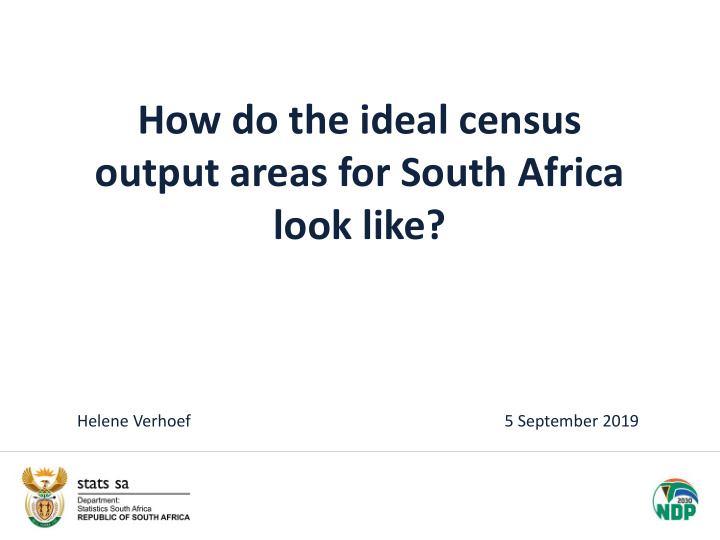



How do the ideal census output areas for South Africa look like? Helene Verhoef 5 September 2019
Introduction Historic statistical geographies Output geographies International trends Research done at Statistics South Africa Characteristics to consider Discussion
Introduction Importance of census data Why not disseminating data on EA level ? Designed to execute a census Workload to be done in 21 days Not the same size – pop / area Population density Terrain plays a role Enumerator walking or driving Literacy and language Time
Output geographies Output geographies are the areas that are used to geo-reference statistical data – statistical geography Standard output geographies Non-standard output geographies National Magisterial districts Province Traditional Areas District Municipalities Metros Wards Local Municipalities Voting districts Main places Sub-places Small Areas Enumeration Areas (Enumeration Areas)
Historic statistical geographies for South Africa Pre 2001 Administrative areas: Province Magisterial districts Urban and Rural Towns 1991 TBVC and sampled areas 1996 Magisterial districts, EAs with place names, Lumped EAs 2001 Administrative areas: Province District Municipalities Local Municipalities and Metros Place name areas: Main places and Sub-places Small Areas
International trends Mixture of administrative and statistical units Refer to Annexure A Annexure A.pdf
International building blocks Building block Country -specific Scale/size Method of type Country name (year) creation England and Ave 17 delivery Postcode Wales Unit postcode points (2001) Automated Ave 30-60 dwellings Australia Mesh block (2011) Hybrid Street block Ave 97 people New Zealand Mesh block (2006) Manual Ave 28 people Hybrid (mostly USA Census block (2010) automated) Ave 6 National square households Grid squares Denmark grid (100 m) (2003) Automated Mean 16 Finland Grid cells (250 m) people (2010) Automated
Standardised building block potential UK motivation for output areas: Temporal stability, min pop (reduced area suppression), max pop (uniformity), intuitive (visible) boundaries, compact shape and homogeneity
Investigation done at Statistics South Africa Ingredients Address / structure coordinates – points Road centre lines / Grid
Urban
Traditional areas
Farms
Gridded population 1996 2011
Gridded population : 2011 SAs
Characteristics to consider for lowest level output areas Should they ideally be: • as small as possible in terms of physical area and population size, • as compact in shape as possible, • as homogeneous as possible – tenure / dwelling type • fall within administrative boundaries • fall within place name areas • be contiguous or holes accepted • null values accepted
These criteria will most likely not be enforceable all at once Need to prioritise in order of importance: absolute enforcement to relaxing Discussion
Contact: helenev@statssa.gov.za +27 012 3108952 +27 0828882521 Skype: verhoef_2
Recommend
More recommend